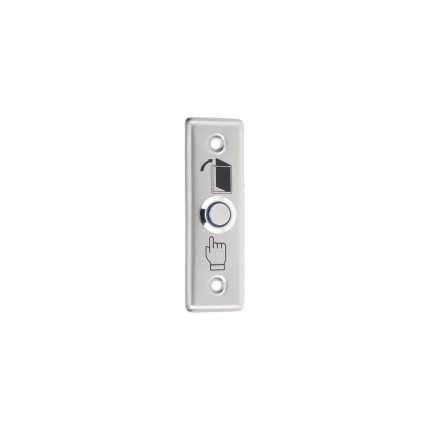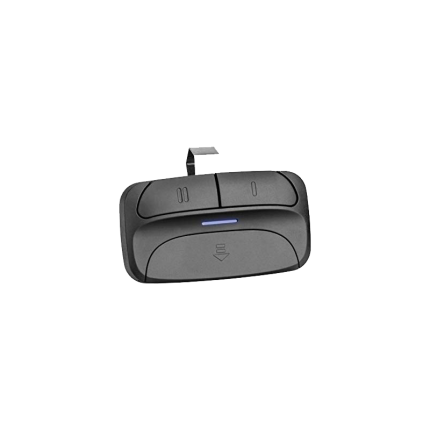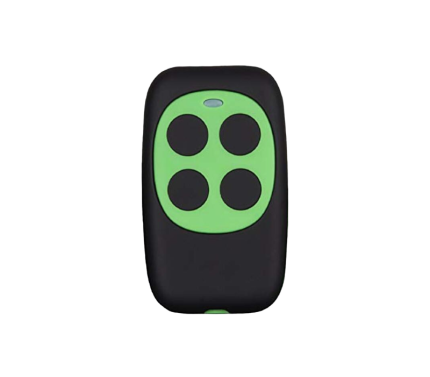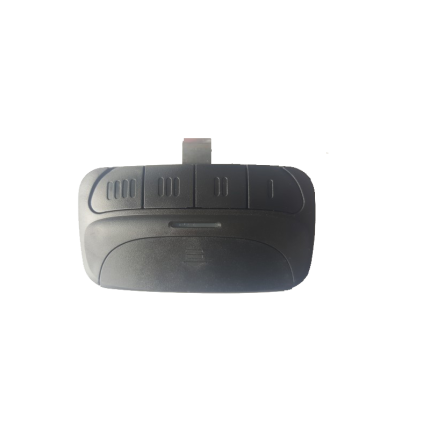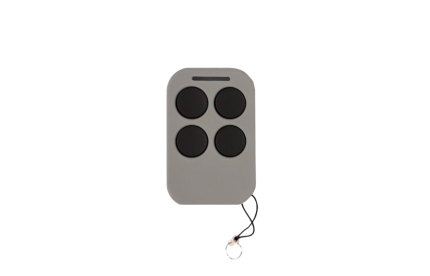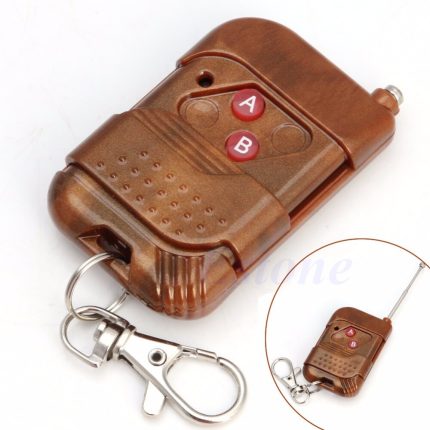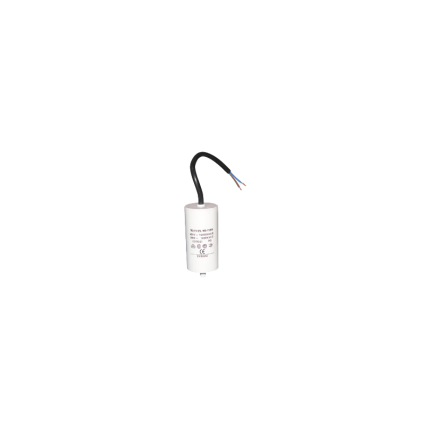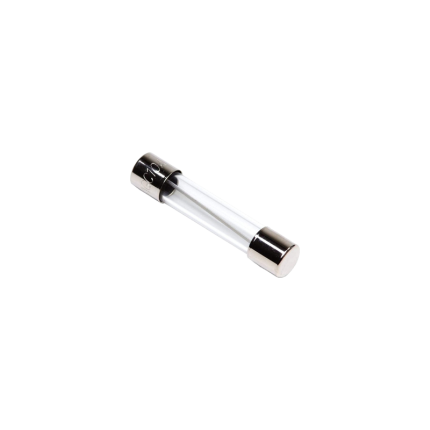gate motor
Garage Door Opener Remote Control
Ship or pick up from our office.
Garage Door Opener Remote Control
A garage door opener remote control is a small, handheld device that uses radio frequency (RF) signals to wirelessly communicate with your garage door opener system. Essentially, it's a transmitter that sends a unique code to a receiver built into your garage door motor unit, telling it to open or close the garage door. Here's a breakdown of how it works and its key features: Functionality:- Signal Transmission: When you press a button on the remote, it sends a radio frequency signal containing a specific code.
- Signal Reception: The garage door opener has a receiver that constantly "listens" for these signals.
- Code Matching: If the received code matches the opener's stored code, the receiver activates the motor.
- Motor Activation: The motor then powers a drive mechanism (chain, belt, screw, or direct drive) that moves the garage door up or down.
- Radio Frequency (RF) Communication: Most remotes operate using RF signals (commonly 315 MHz or 390 MHz), allowing them to work from a distance and even through walls.
- Fixed Code Technology (Older): Early remotes used a fixed code that was sent every time. This was less secure as the signal could be easily intercepted and duplicated.
- Rolling Code Technology (Modern): To improve security, modern remotes use rolling code technology. The code changes every time you press the button, making it extremely difficult for unauthorized individuals to "grab" and reuse the code. Brands like LiftMaster (Security+ / Security+ 2.0) and Genie (Intellicode®) use their own versions of this.
- Dip Switches (Older): Some older remotes used physical dip switches that needed to be manually set to match the receiver's code.
- Wi-Fi and Smart Home Integration: Many newer garage door openers feature built-in Wi-Fi, allowing you to control your garage door from anywhere using a smartphone app (e.g., MyQ for LiftMaster/Chamberlain, Aladdin Connect for Genie). These apps often offer additional features like real-time notifications, scheduling, and access history.
- Multi-Button Remotes: Some remotes have multiple buttons, allowing you to control several garage doors or even other devices like lights.
- Universal Remotes: These are programmable remotes designed to be compatible with various brands and models of garage door openers, reducing the need for multiple remotes.
- Standard Remotes: Basic remotes with one or more buttons to operate the garage door.
- Visor Remotes: Larger remotes designed to clip onto your car's sun visor for easy access while driving.
- Keychain Remotes: Small, compact remotes that can be attached to your keyring for portability.
- Keypad Remotes: Mounted outside your garage door, these allow you to enter a numerical code to open the door, useful for keyless entry.
Gate Opener Remote Control
Ship or pick up from our office.
Gate Opener Remote Control
(More than 100 different designs) *433 MHz *2-5 Buttons A gate opener remote control is a handheld device that allows you to wirelessly open and close an automatic gate from a distance. It's a key component of an automated gate system, offering convenience and enhanced security for residential, commercial, and industrial properties. Here's a breakdown of what it is and how it works: What it is:- Handheld device: Typically small and portable, often designed to be kept in a car, on a keychain, or mounted on a visor.
- Transmitter: It contains a small radio transmitter that sends a wireless signal.
- User interface: Usually features one or more buttons to command the gate (e.g., open, close, stop).
- Signal Transmission: When you press a button on the remote, it sends a digitally encoded radio frequency (RF) signal (typically in the 300 to 900 MHz range) through the air.
- Signal Reception: A receiver unit, connected to the gate motor, is tuned to the same frequency as the remote. It picks up this signal.
- Signal Decoding: The receiver interprets the coded information embedded in the signal to understand the desired action (e.g., open the gate).
- Motor Activation: The decoded signal is sent to the gate's control board, which then activates the gate motor.
- Gate Movement: The motor, through various mechanisms (gears, chains, arms), physically moves the gate to open or close.
- Convenience: Allows you to operate the gate without leaving your vehicle, especially useful in bad weather or at night.
- Security: Provides controlled access to your property, deterring unauthorized entry. Many modern remotes use "rolling code" technology, which changes the code with each use, making it harder for unauthorized individuals to intercept and duplicate the signal.
- Range: Typically works within a certain distance, ranging from 20-50 feet up to 100 feet or more, depending on the model and environment.
- Compatibility: Most remotes are designed to work with specific gate opener brands and models, though universal remotes exist that can be programmed to work with various systems.
- Multiple Remotes: Many gate openers can be paired with multiple remotes, allowing several authorized users to control the gate.
- Integration: Some advanced systems can be integrated with smartphone apps, keypads, or other smart home devices for even greater control and monitoring.
- Safety Features: Often used in conjunction with safety sensors (like photo eyes or pressure sensors) that detect obstructions and prevent the gate from closing on people or objects.
Gate Opener Remote Control
Ship or pick up from our office.
Gate Opener Remote Control
– Copy Code typeGate opener remote controls use two main code types for copying: fixed code and rolling code.
Fixed code remotes are simpler and easier to clone, while rolling code remotes offer enhanced security and require more advanced techniques for copying.
Gate Opener Remote Control Fixed Code type:
- How it works: A fixed code remote transmits the same code every time it's pressed.
- Cloning: These are generally easier to clone using a universal remote duplicator.
- Security: Less secure than rolling code, as the code can be intercepted and copied.
- Example: Commonly found in older or simpler gate opener systems.
Gate Opener Remote Control
Ship or pick up from our office.
Gate Opener Remote Control
*With Visor Clip *433 MHz *4 ButtonsGate Opener Remote Control -C4
Ship or pick up from our office.
Gate Opener Remote Control -C4
*433 MHz
*2-4 Buttons
*More than 10 different designs
Key features and functions of a gate opener remote control:
-
Remote Operation:Enables opening and closing the gate from a distance, typically within a certain range (e.g., 100 feet).
-
Radio Signal Transmission:Emits a radio signal to the gate's receiver unit, initiating the gate's movement.
-
Compatibility:Most remotes are compatible with specific gate openers and require the same frequency to function.
-
Programming:Can be programmed with the gate's receiver unit, often involving a "learn" or "program" button on the gate opener.
-
Multiple Remotes:Many gate openers can be paired with multiple remotes, allowing multiple users to control the gate.
-
Universal Remotes:Some universal remotes can be programmed to work with different gate opener brands, as long as they are compatible.
-
Safety Features:Some gate openers incorporate safety features like sensors that detect obstructions and reverse the gate's movement.
Gate Opener Remote Control 1400FT315
Ship or pick up from our office.
Gate Opener Remote Control 1400FT315
*High-Range 1400ft *315 MHz *Compatible with HomeLink system on vehicles *1 channelGate Opener Remote Control 1400FT315/2-CH
Ship or pick up from our office.
Gate Opener Remote Control 1400FT315/2-CH
A high-range gate opener remote control 1400FT315/2-CH allows you to operate your gates from a greater distance than standard remotes, typically offering a range of several hundred feet or even up to a mile or more.
These remotes are often used in situations where the gate is located far from the entrance or when there are obstructions between the remote and the receiver.
Here's a more detailed explanation about Gate Opener Remote Control 1400FT315/2-CH:
What makes it high-range?
-
Stronger Transmitter:High-range remotes have a more powerful transmitter than standard remotes, allowing them to send a stronger signal over a longer distance.
-
Specialized Receiver:These remotes often work with a specialized receiver that is more sensitive and capable of picking up weaker signals.
-
Frequency:High-range remotes typically operate on a specific frequency (e.g., 433MHz or 315MHz) that is less prone to interference and allows for better transmission.
Benefits of high-range remotes like as the Gate Opener Remote Control 1400FT315/2-CH:
-
Increased Convenience:You can open your gate from a greater distance, which is particularly useful for large properties or when driving up to the gate.
-
Improved Security:High-range remotes can help prevent unauthorized access by allowing you to activate the gate from a safe distance.
-
Enhanced Flexibility:They can be used in a wider range of situations, such as when you need to open the gate for deliveries or visitors.
Factors affecting range:
-
Line of Sight:The range is usually maximized when there is a clear line of sight between the remote and the receiver.
-
Obstructions:Walls, trees, and other obstructions can reduce the range of the remote.
-
Weather Conditions:Extreme weather conditions like heavy rain or snow can also affect the range.
-
Antenna Placement:Proper placement of the antenna on the receiver can help improve the range.
Gate operator capacitor
Ship or pick up from our office.
Gate operator capacitor
A gate operator capacitor is an electrical component that assists the motor in a gate opener system to start and run smoothly.
It stores and releases electrical energy to provide the initial torque needed to get the motor going and to ensure consistent operation. These capacitors are crucial for both swing and sliding gate openers that are powered by AC.
Here's a more detailed explanation:
-
Starting the Motor:When a gate opener is activated, the motor needs a significant amount of power to begin rotating. The capacitor provides a burst of electrical energy to help the motor overcome its inertia and start moving.
-
Maintaining Smooth Operation:Once the motor is running, the capacitor helps to smooth out the electrical current, ensuring consistent and efficient operation. This prevents the motor from stalling or experiencing performance issues due to voltage fluctuations.
-
Types of Capacitors:Gate operator capacitors can be categorized as either start capacitors or run capacitors.
- Start capacitors: are used to provide the initial surge of power needed to get the motor rotating.
- Run capacitors: help to maintain consistent motor performance during operation.
- Start capacitors: are used to provide the initial surge of power needed to get the motor rotating.
-
Common Applications:Capacitors are used in various gate operator systems, including:
- Swing gate openers
- Sliding gate openers
- Commercial and residential gate systems
- Barrier arms
- Overhead doors
- Swing gate openers
-
Compatibility:Different gate operators may require specific types and sizes of capacitors, so it's important to choose the right replacement capacitor for your system.
Gate operator capacitor
Ship or pick up from our office.
Gate operator capacitor
A gate operator capacitor is an electrical component that assists the motor in a gate opener system to start and run smoothly.
It stores and releases electrical energy to provide the initial torque needed to get the motor going and to ensure consistent operation. These capacitors are crucial for both swing and sliding gate openers that are powered by AC.
Here's a more detailed explanation:
-
Starting the Motor:When a gate opener is activated, the motor needs a significant amount of power to begin rotating. The capacitor provides a burst of electrical energy to help the motor overcome its inertia and start moving.
-
Maintaining Smooth Operation:Once the motor is running, the capacitor helps to smooth out the electrical current, ensuring consistent and efficient operation. This prevents the motor from stalling or experiencing performance issues due to voltage fluctuations.
-
Types of Capacitors:Gate operator capacitors can be categorized as either start capacitors or run capacitors.
- Start capacitors: are used to provide the initial surge of power needed to get the motor rotating.
- Run capacitors: help to maintain consistent motor performance during operation.
- Start capacitors: are used to provide the initial surge of power needed to get the motor rotating.
-
Common Applications:Capacitors are used in various gate operator systems, including:
- Swing gate openers
- Sliding gate openers
- Commercial and residential gate systems
- Barrier arms
- Overhead doors
- Swing gate openers
-
Compatibility:Different gate operators may require specific types and sizes of capacitors, so it's important to choose the right replacement capacitor for your system.
Gate operator control board fuse
Ship or pick up from our office.
Gate operator control board fuse
A gate operator control board fuse is a critical safety component found on the circuit board of an automatic gate system. Its primary function is to protect the electrical components of the gate operator from damage caused by excessive current, such as a short circuit or an overload. Essentially, it acts as a sacrificial link in the electrical circuit. If the current flowing through the circuit exceeds a predetermined safe limit, the thin metal wire or strip inside the fuse melts and breaks the circuit. This prevents the surge of electricity from reaching and damaging more expensive and vital components on the control board or in the motor. Types and Characteristics Gate operator control board fuses come in various amperage ratings, typically ranging from 0.2 to 15 amps, depending on the specific gate operator model and its power requirements. Some common characteristics include:- Slow-Blow/Time-Delay Fuses: Many gate operators use "slow-blow" or "time-delay" fuses. These fuses are designed to tolerate brief, temporary current surges that often occur when motors start up without immediately blowing. They only interrupt the circuit if the overload persists for a longer duration.
- Physical Form: They can be found in various physical forms, including glass tube fuses (common in older models), blade-style automotive fuses, or sometimes as surface-mount fuses directly on the printed circuit board.
- Short Circuit: A direct path for current to flow, bypassing the normal resistance, causing a sudden and large surge.
- Overload: The gate motor or another component drawing more current than it's designed for, perhaps due to mechanical obstruction, a faulty motor, or issues with the gate's movement (e.g., binding hinges, gate dragging on the ground).
- Component Failure: A faulty component on the control board or within the gate operator system itself can cause an abnormal current draw, leading the fuse to blow.
- Power Surges: External power surges from the main electrical supply or lightning strikes can also cause fuses to blow.
- Disconnect Power: Always disconnect all power to the gate operator before attempting any inspection or repair. This includes both AC power and any battery backup systems.
- Locate the Fuse: The fuse is typically located directly on the main control board, often in a small holder or a clear cover. Refer to your gate operator's manual for its exact location.
- Inspect the Fuse:
- For glass tube fuses, you can often visually inspect the wire inside; if it's broken or discolored, the fuse is blown.
- For blade-style fuses, there might be a visible break in the metal strip, or you can use a multimeter set to continuity mode. A blown fuse will show no continuity.
- Replace the Fuse: If the fuse is blown, replace it with a new fuse of the exact same amperage (ampere) and voltage rating. Using a fuse with a higher rating can lead to damage to the control board or other components, as it won't blow when it should. Using a lower rating may cause the fuse to blow unnecessarily.

